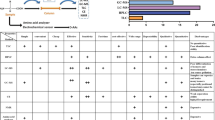Abstract
Antisera have been developed against the wholecell antigens of Desulfovibrio africanus Benghazi and Walvis Bay, D. vulgaris Hildenborough, D. salexigens British Guiana, D. gigas, and D. desulfuricans Essex 6. An enzymelinked immunoadsorption assay (ELISA) was developed to measure the reaction of these antisera with the homologous and heterologous antigens. The ELISA method demonstrated a reaction between pre-immune sera and cells of D. africanus, D. gigas and D. desulfuricans, suggesting the presence of a lectin-like substance on these cell surfaces. Extensive cross-reactions were seen between the antisera and heterologous cells, suggesting the sharing of a number of surface antigens amongst the Desulfovibrio. However, the pattern of these cross-reactions was different from that observed for an ELISA reaction developed for the cytochrome c3 from various Desulfovibrio.
Similar content being viewed by others
Abbreviations
- ELISA:
-
enzyme-linked immunoadsorption assay
References
Abdollahi H, Nedwell DB (1980) Serological characteristics within the genus Desulfovibrio. Antonie van Leeuwenhoek J Microbiol Seriol 46:73–83
Campbell LL, Kasprzycki MA, Postgate JR (1966) Desulfovibrio africanus sp n, a new dissimilatory sulfate-reducing bacterium. J Bacteriol 92:1122–1127
Cumming CG, Ross PW, McBride IR (1980) Grouping of β-haemolytic streptococci by enzyme-linked immunosorbent assay. J Med Microbiol 13:459–461
Lis H, Sharon N (1977) Lectins: their chemistry and application to immunology. In: Sela, M (ed) The antigens, vol 4. Academic Press, New York, pp 429–529
Postgate JR (1982) Economic importance of sulphur bacteria. Phil Trans Royal Society Lond B 298:583–600
Postgate JR, Campbell LL (1963) Identification of Coleman's sulfate-reducing bacterium as mesophilic relative of Clostridium nigrificans. J Bacteriol 86:274–279
Postgate JR, Kent HM, Robson RL, Chesshyre SA (1984) The genomes of Desulfovibrio gigas and D. vulgaris. J Gen Microbiol 130:1597–1602
Singleton R Jr, Campbeli LL, Hawkridge FM (1979) Cytochrome c3 from the sulfate-reducing anaerobe, Desulfovibrio africanus Benghazi: Purifications and properties. J Bacteriol 140:893–901
Singleton R Jr, Denis J, Campbell LL (1982) Cytochrome c3 from the sulfate-reducing anaerobe, Desulfovibrio africanus Benghazi: Antigenic properties. J Bacteriol 152:527–529
Singleton R Jr, Denis J, Campbell LL (1984) Antigenic diversity of cytochrome c3 from the anaerobic sulfate-reducing bacteria, Desulfovibrio. Arch Microbiol 139:91–94
Smith AD (1982) Immunofluorescence of sulfate-reducing bacteria. Arch Microbiol 133:118–121
Wadstrom T, Trust TJ, Brooks DE (1983) Bacterial surface antigens. In: Bog-Hansen TC, Spengler GA (eds) Lectins, vol 3. Walter de Gruyter, Berlin, pp 479–494
Voller A, Bidwell, DE, Bartlett A (1979) The enzyme linked immunoadsorption assay (ELISA). Dynatech Laboratories, Alexandria, VA
Author information
Authors and Affiliations
Rights and permissions
About this article
Cite this article
Singleton, R., Denis, J. & Campbell, L.L. Whole-cell antigens of members of the sulfate-reducing genus Desulfovibrio . Arch. Microbiol. 141, 195–197 (1985). https://doi.org/10.1007/BF00408057
Received:
Accepted:
Issue Date:
DOI: https://doi.org/10.1007/BF00408057




